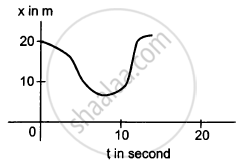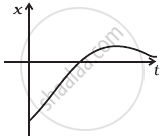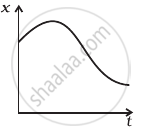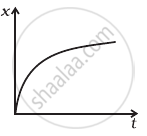Advertisements
Advertisements
Question
Among the four graphs (Figure), there is only one graph for which average velocity over the time intervel (0, T ) can vanish for a suitably chosen T. Which one is it?
Options
Solution
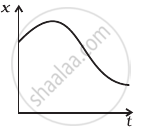
Explanation:
The main concept used: Average velocity of the body will sum up to zero (average velocity is total displacement by total time). Here the above graphs show displacement for different timings in any time interval-T in the x-t graph.
We must locate the graph in which there is both positive and negative displacement at various timings, implying that these displacements are in opposing directions and that when these opposite displacements are added, net displacement or the average velocity is zero. Only in the graph is this feasible (b).

If we draw a line from point (A) on the graph at t=0 sec which is parallel to the time axis. This line can intersect the graph at B once more. Because the change in displacement (O-T) time is zero at this point, i.e., the displacements at A and B are equal, the average velocity of the body vanishes to zero.
APPEARS IN
RELATED QUESTIONS
The following figure gives the x-t plot of a particle in one-dimensional motion. Three different equal intervals of time are shown. In which interval is the average speed greatest, and in which is it the least? Give the sign of average velocity for each interval.
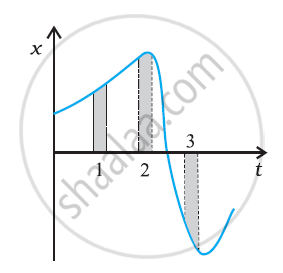
A ball is thrown vertically upward with a speed of 20 m/s. Draw a graph showing the velocity of the ball as a function of time as it goes up and then comes back.
A person travelling on a straight line moves with a uniform velocity v1 for some time and with uniform velocity v2 for the next equal time. The average velocity v is given by
Pick the correct statements:
(a) Average speed of a particle in a given time is never less than the magnitude of the average velocity.
(b) It is possible to have a situation in which
(d) The average velocity of a particle moving on a straight line is zero in a time interval. It is possible that the instantaneous velocity is never zero in the interval. (Infinite accelerations are not allowed).
Mark the correct statements:
It is 260 km from Patna to Ranchi by air and 320 km by road. An aeroplane takes 30 minutes to go from Patna to Ranchi whereas a delux bus takes 8 hours. Find the average speed of the plane.
It is 260 km from Patna to Ranchi by air and 320 km by road. An aeroplane takes 30 minutes to go from Patna to Ranchi whereas a delux bus takes 8 hours. Find the average speed of the bus.
It is 260 km from Patna to Ranchi by air and 320 km by road. An aeroplane takes 30 minutes to go from Patna to Ranchi whereas a delux bus takes 8 hours. Find the average velocity of the plane.
In the following figure shows the graph of the x-coordinate of a particle going along the X-axis as a function of time. Find the average velocity during 0 to 10 s,
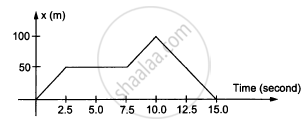
In the following figure shows x-t graph of a particle. Find the time t such that the average velocity of the particle during the period 0 to t is zero.
